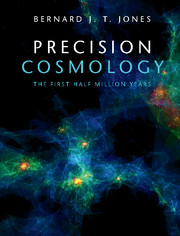Book contents
- Frontmatter
- Dedication
- Contents
- Preface
- Notation and Conventions
- Part I 100 Years of Cosmology
- 1 Emerging Cosmology
- 2 The Cosmic Expansion
- 3 The Cosmic Microwave Background
- 4 Recent Cosmology
- Part II Newtonian Cosmology
- Part III Relativistic Cosmology
- Part IV The Physics of Matter and Radiation
- Part V Precision Tools for Precision Cosmology
- Appendix A SI, CGS and Planck Units
- Appendix B Magnitudes and Distances
- Appendix C Representing Vectors and Tensors
- Appendix D The Electromagnetic Field
- Appendix E Statistical Distributions
- Appendix F Functions on a Sphere
- Appendix G Acknowledgements
- References
- Index
2 - The Cosmic Expansion
from Part I - 100 Years of Cosmology
Published online by Cambridge University Press: 04 May 2017
- Frontmatter
- Dedication
- Contents
- Preface
- Notation and Conventions
- Part I 100 Years of Cosmology
- 1 Emerging Cosmology
- 2 The Cosmic Expansion
- 3 The Cosmic Microwave Background
- 4 Recent Cosmology
- Part II Newtonian Cosmology
- Part III Relativistic Cosmology
- Part IV The Physics of Matter and Radiation
- Part V Precision Tools for Precision Cosmology
- Appendix A SI, CGS and Planck Units
- Appendix B Magnitudes and Distances
- Appendix C Representing Vectors and Tensors
- Appendix D The Electromagnetic Field
- Appendix E Statistical Distributions
- Appendix F Functions on a Sphere
- Appendix G Acknowledgements
- References
- Index
Summary
The inter-war years, 1918–1939, were a period of coming to terms (a) with Einstein's General Relativity and (b) with Hubble's discovery of the redshift–distance relationship. By the end of the period our cosmological framework was understood well enough in terms of an expanding homogeneous and isotropic solution of the Einstein equations and it probably seemed a matter of acquiring redshift in order to settle the parameters of the model. Two parameters would do the job.
It could not have been imagined that by 1955 there would be a heated argument between two camps: Gamow, who said there was a Hot Big Bang, and Hoyle, Bondi and Gold who said there was not. Added to that was another heated, even acrimonious, argument about the interpretation of the counts of recently discovered radio sources made by Ryle in Cambridge, England and Mills in Sydney, Australia. Ten year after that we had the Quasars and Cosmic Microwave Background Radiation (CMB) that, at the time, not everyone believed was cosmic in origin.
This chapter relates some of that story. It is an essential part of explaining how come we are where we are.
Models of the Cosmic Expansion
Several spatially homogeneous solutions of the equations of the General Theory of Relativity were discovered within the first decade following their publication (Einstein, 1916a). At that time relatively little was known about the Universe: it was still uncertain whether or not the nebulae were merely parts of our own Galaxy, although, through the pioneering work of Slipher, it was known that most of them were rushing away from us. Little or nothing was known about the homogeneity or isotropy of the Universe, but the assumption of homogeneity and isotropy would simplify the largely intractable Einstein equations. During the decade following the publication of the Einstein equations several important cosmological solutions were discovered. These are discussed next.
It is interesting in this context to read and compare the texts of Eddington (1923), published before Edwin Hubble's study of the nebulae and his consequent discovery of the cosmic expansion, and the text of Tolman (1934b) which was published shortly thereafter. The search for understanding the Universe in terms of models is beautifully described in Michael Heller's Ultimate Explanations of the Universe (Heller, 2010).
- Type
- Chapter
- Information
- Precision CosmologyThe First Half Million Years, pp. 19 - 47Publisher: Cambridge University PressPrint publication year: 2017



